 |
||
|
||
| ||
The comparison testing of the Pro266 chipset based boards made the readers think about the changes in the sphere of processors and mainboards, and refreshed a fading out interest to the DDR memory. The fight of processors is paid much greater attention to today than the competition of chipsets. Pentium 4 processors based on the 0.18 micron fab process are swiftly lifting their clock frequencies and reducing their prices. You all know that the Pentium 4 2 GHz will be announced at the end of August, while younger and middle models of this line will be close to $100. Following the Pentium III, AMD Athlon branch turned out to be in the dead end - the difference between P4 and Athlon is around 500 MHz and it will be growing further, that is why Intel has again taken the leading position in the performance among desktop systems. The NetBurst architecture, which the P4 based on, is in an advantageous position because the transfer to the 0.13 micron process has become too slow, and AMD has to maintain the interest to its products by cutting the prices. The users, however, only benefit from such situation. Lower models of the Athlon processor which demonstrates a decent productivity for 90% of applications are becoming cheaper and cheaper. So is the DDR memory which is already equal to SDR in price. It has placed the high-efficient AMD processor based systems into the mainstream sector. Today everyone who has extra $20-40 should think about the DDR memory since it gives the promised 10% performance boost. So, we have only to make a choice of a chipset. Today we will look what the VIA KT266 based boards are capable of and what they will get with the release of new revisions and BIOS. So, here are the contestants.
Epox 8KHA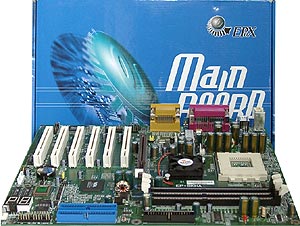 During the last year the boards from this Taiwanese company has become very popular: they have both high speed characteristics and good consumer qualities. This company was almost the first to offer such functions as IDE RAID onboard and a convenient monitoring of computer booting. The today's board packed in a standard blue box is supplied with 40- and 80-conductor cables for IDE devices, an FDD cable and a bracket with two additional USB connectors or the rear computer panel. A thick board description gives you all necessary instructions for installation of the board and drivers. Besides, there is a CD with drivers and a modest set of freeware programs, among which are Adobe Acrobat Reader 4.05, Norton Antivirus 2001 and Norton Ghost 6.03. Besides, there is a utility for measuring a processor frequency from DOS or Windows - Boostek. 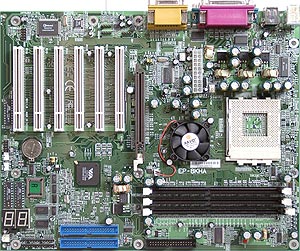 CD-in and AUX-in connectors are placed in front of the first PCI slots - it has nearly become a standard for the manufacturers, but it isn't convenient for assemblers. Besides, the company has decided to save on plastic for these connectors. The cables will undoubtedly fall out from such connectors. On the other hand, there is a clamp on the AGP connector and an AAVID's cooler on the north bridge of the chipset. Besides, there are two standard 7-segment LEDs for monitoring the POST procedure. The codes displayed on them are described in the manual. The feed circuits have 12 LowESR capacitors of 2200uF each. 2 switches are meant for cleaning the CMOS and for choosing the base frequency - 100 or 133 MHz. All other settings can be made from the BIOS Setup. The BIOS is based on the v6.00 from Award and includes a great deal of possibilities for adjusting memory timings, AGP and PCI buses operation and a possibility to distribute manually interrupts among PCI slots. The FSB frequency can be changed from 100 to 200 MHz in 1 MHz steps. The core voltage can be changed +/- 0.1V in 0.025V steps and the memory voltage can be lifted by 0.7V from the rated value in 0.1V increments. Soltek 75DRV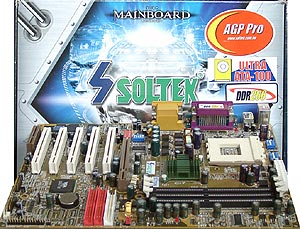 Since the board has arrived quite a long time ago, the package and a software set are quite old. Today the boards from this company ship in new boxes and has a richer software set. If you want to take a look at the new box and at the new software you should turn to the review of Pro266 chipset based boards. Inside the box there are a user's manual, a separate description of the freeware programs, one ATA66/100 cable (80-conductor) and an FDD one. Unfortunately, there is no the second IDE cable (while in the new package it is present) and a cable with additional USB connectors. One of two CDs supplied with the board contains drivers and descriptions of different Soltek boards and several programs such as Adobe Acrobat Reader and Virtual Drive. The second disc has three more programs - Norton Antivirus 2001, Norton Ghost 6.03 and Winfax Pro 9. As I have already said, one of the booklets contains a detailed description of these programs. 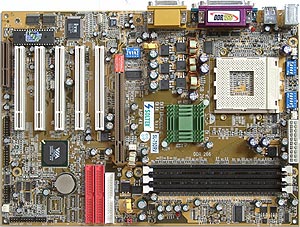 The board is equipped with an AGP Pro connector which you can use for a video card with an increased power consumption. The feed circuits contain 6 3300uF and 4 2200uF capacitors. Among disadvantages I want to mark a CD-in connector which is placed between 1 and 2 PCI slots. The board has 3 units of DIP-switches for regulation of Vcore, a multiplier and a FSB frequency. Two of these settings are also included into the BIOS. The BIOS is based on the v6.0 from Award and contains a heap of settings, such as fine regulation of timings of memory and of AGP bus. The Red Storm Overclocking technology will help you overclock the processor in auto mode and it has the best system of intellectual determining of the extreme frequencies without detriment to stability. The AntiBurn Shield technology won't let the processor burn and will turn off the system in case of such bugs as stoppage of the cooler's fan. Besides, you can manually distribute interrupts among PCI slots. The board looks a very serious competitor, like all other boards we managed to put our hands on. It should be noted that all of them are based on VIA chipsets. Chaintech 7VJD & 7VJD2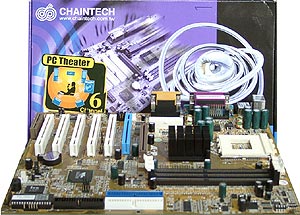 Since the boards are almost identical (except connectors for DIMM SDR SDRAM present on the second board), do not differ in positioning of functional elements and have the same accessories it makes sense to describe them together. 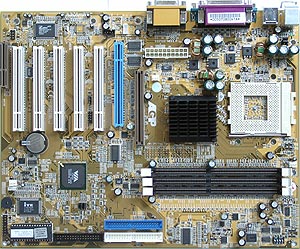 The 7VJD and 7VJD2 have 5 PCI slots, 1 CNR and 1 ACR. The standard blue and purple box contains also a detailed description of the board and installation instructions, an 80-conductor cable ATA66/100, a cable for FDD and for a 6-channel acoustic system. One of two CDs contains drivers for the Chaintech boards and a utility CPUBoost to change a processor frequency and some other parameters right from the Windows. Unfortunately, it suits only clock oscillators from Realtek. The second CD named "Value Pack 2001" contains Adobe Active Share (for viewing photos, creation of albums and exchange of them via the Net), Norton Antivirus 2001, Adobe Acrobat Reader 4.05, AutoSave, Ewalla (a partial substitute for an e-mail client with the help of funny animals and small cars), Appio (a personal helper for making purchases on the Net), X-Stop (for restricting access to definite sites and definite pictures). Such a software set is mainly intended for a usual user than for a professional.  The boards do not differ much: the 7VJD2 has 2 slots for DDR SDRAM, while the 7VJD has 3. At the same time, the former has 2 slots for SDRAM. It may be easier for a user to turn to the more efficient memory type. But with the today's prices such solution may seem doubtful. The layout is competent, except minor drawbacks: power supply and audio-in connectors are placed not very conveniently. The sound is from C-Media, so you can listen to the music on the 5.1 audio system with the help of a bracket for the rear computer panel. Each board has 10 3300uF capacitors to make operation more stable. There are also several jumpers for cleaning the CMOS and for setting the base processor frequency - 100 or 133 MHz. The third one is made as a unit of switches for changing the processor multiplier. All other settings are included into the BIOS Setup. The BIOS based on the v6.00PG from Award will help you adjust memory modes, AGP and PCI buses modes, distribute interrupts manually among PCI devices and overclock the processor. The core voltage can be lifted by 0.35V in 0.025V steps, and the FSB frequency can be changed in 1 MHz increments up to 166 MHz. MSI K7T266 Pro The sample we managed to fetch is both high-quality and high-efficient.
 All functional elements are placed very conveniently. There are several unsoldered chips and connectors - the matter is that the PCB serves a base for several models. The AGP connector has a clamp to fix a video card in the slot. There are 5 4700uF LowESR capacitors. Two jumpers are intended for cleaning the CMOS and for setting the base CPU frequency - 100 or 133 MHz. All other settings can be done from the BIOS. The BIOS is based on v1.24 from AMI and contains many regulators of AGP and PCI buses, wide possibilities for fine adjustment of memory. Besides, you can change Vmem (from 2.5 to 2.7V in 0.1V steps) and Vcore (1.475 - 1.85V in 0.025V steps), set the multiplier (from X5 to X12.5) and change a FSB frequency up to 153 MHz in 1 MHz steps. The only thing the board lacks for is a function of manual distribution of interrupts among PCI slots. ASUS A7V266 This first ASUS'es board based on the KT266 from VIA was released when all other board makers have already launched their boards on this chipset. Maybe the company didn't want to release a raw product. Well, let's look at it. The board we received is just a pre-production sample. However, the board was supplied together with the documentation, an ATA100, FDD cables and a CD-R disc. The latter contains a standard set of programs from Asustek - drivers for the board, Adobe Acrobat Reader 4.05, PC-Cillin2000 v. 7.0 from Trend Micro, Power Player SE 5.0, PowerDVD Trial 3.0, VideoLive Mail 4.0 from CyberLink, 3Deep for adjusting colors in games, and programs from ASUS - a screensaver, ASUS Update and ASUS PCProbe - a system status monitoring utility. The board has unsoldered chip and connectors meant for IDE RAID controller from Promise with the corresponding ATA100 connectors. 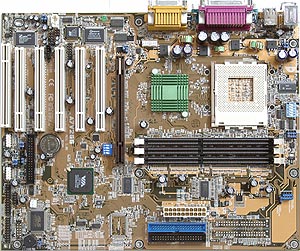 The sound solution is external: there is a chip from C-Media with sound output through 6 channels. But a bracket for the rear panel is absent, and Line-In and Mic-In connectors become outputs of a central and rear channels with the help of drivers. The only drawback is a location of a connector for a FDD cable: it is placed behind 4 and 5 PCI slots, thus making the cable stretching along the whole case. The board has 4 3300uF and 3 1500uF capacitors. Besides, there are SMARTCARD and AFPANEL connectors (the latter is meant for connecting ASUS iPanel). Among a great deal of jumpers the most interesting are 4 units of switches: for setting a base processor frequency, a multiplier and Vcore. The fourth will help you choose a processor type - Athlon, Duron or Athlon 4 (Palomino). The most of settings are hidden in the BIOS Setup. The BIOS is based on the v. Medallion 6.00 from Award. It offers a great variety of modes for memory, AGP and PCI buses; you may manually distribute interrupts among slots etc. With the JumperFree technology you can change many characteristics of the system from the BIOS Setup in the version of Asustek. There are such possibilities as a choice of Vcore (1.525-1.85V, 0.025V step), a choice of a multiplier (x5-x13), of a FSB frequency (100-227MHz(!) in 1 MHz steps). Gigabyte 7VTX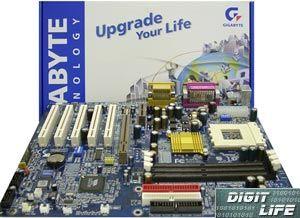 This board was already tested in the review of the VIA KT266 chipset, and there is almost nothing new to add. In a usual blue and white box you can find an ATA66/100 and FDD cables, a user's manual and a CD with drivers and utilities. Among the programs you can find EasyTune III for overclocking the system from the Windows, @BIOS for updating the BIOS from Windows. 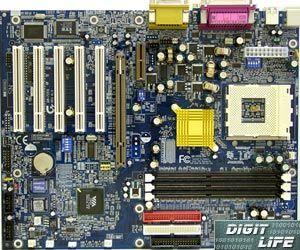 The board we tested previously differs from the today's one in an unsoldered connector for extra feeding of an AGP slot, and a fan from AVC on the heatsink of the north bridge. All elements are placed competently. Among other peculiarities there are three-phase supply of the processor and 13 LowESR 1200uF capacitors. There are also units of switches for changing a FSB frequency, a multiplier and for adjusting voltage of the AGP bus and memory modules. The BIOS is based on v1.24 from AMI and helps to adjust timings of memory and AGP bus, to change a FSB frequency in 1 MHz steps up to 180 MHz and to set a coefficient of correlation of AGP/PCI/FSB frequencies. I wish only there was a possibility to change Vcore. PerformanceTest equipment:
Software:
We included into the diagrams the results obtained on all DDR chipsets for Athlon tested in our lab. Nevertheless, despite the fact that all additional test equipment is the same, two month difference make us considering the results obtained on all chipsets except KT266 approximate. On the other hand, they make the picture more complete, and the comparison testing of all the fastest mainboards on all modern chipsets will dot all "i's" and cross all "t's". That review will contain detailed comments to each test, while this one demonstrates the performance of the KT266 boards. 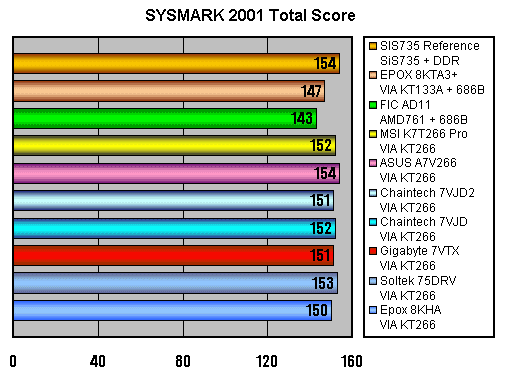 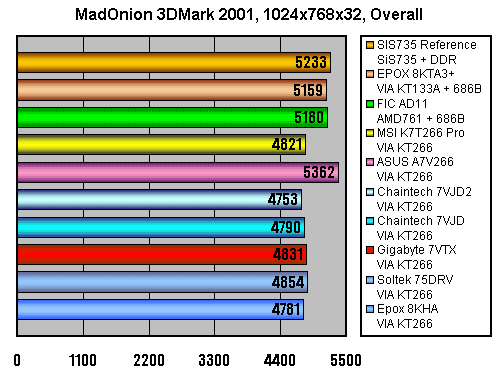 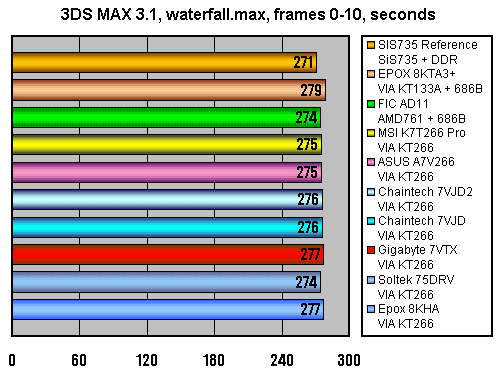  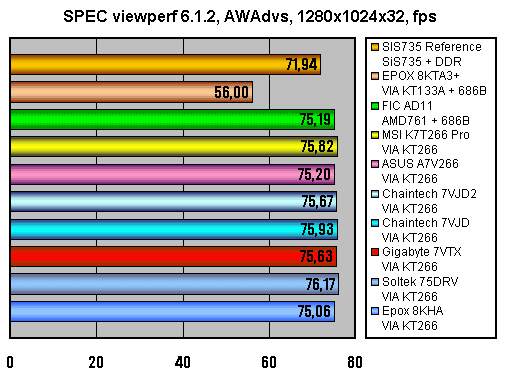 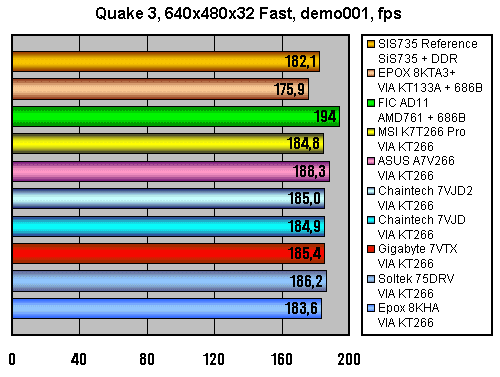 First, let me comment the results without taking into consideration the performance of the ASUS board. All the boards correspond to the high level. But almost in all tests the Soltek 75DRV is leading. The EPOX 8KHA is always a bit behind its competitors. And the Chaintech proved once again that the boards with support of two memory types are slower than their brothers with DDR SDRAM support. Now the ASUS A7V266. Is it a new revision of the chipset or a competent tuning? The official version explains such a performance boost in 3D by the sharp design and the debugged BIOS. You may notice that the diagrams lack for the performance results of the VIA KT266 + PC133. We conducted some tests (Quake III and 3DMark 2001), but it makes no sense to display the results. With the allowance for the performance difference between different motherboard we may say that KT266 + PC133 performs as good as KT133A + PC133 (sometimes slower by 2-3%, but the KT266 and KT133A based boards are from different manufacturers). On the other hand, when you are buying the KT266 board with PC133 and PC2100 DDR support it's useless to rely on its high efficiency when coupled with the PC133. This board may serve you until you get normal PC2100 DDR memory. ConclusionSo, if you need high performance and the price doesn't matter much for
you it's better to pay attention to the ASUS A7V266, but if you want a
solution with an ideal price/quality ratio, than look at the Soltek 75DRV
and EPOX 8KHA.
Write a comment below. No registration needed!
|
Platform · Video · Multimedia · Mobile · Other || About us & Privacy policy · Twitter · Facebook Copyright © Byrds Research & Publishing, Ltd., 1997–2011. All rights reserved. | |||||||||||||||||||||||||||||||||||||||||||||||||||||||||||||||||||||||||||||||||||||||||||||||||||||||||||||||||||||||||||||||||||||||||||